Nizam of Hyderabad: Difference between revisions
→References: removed possible pov |
moved text from main page: Hyderabad, India |
||
| Line 42: | Line 42: | ||
Because Hyderabad did not participate in the [[Indian Rebellion of 1857|first war of Indian Independence of 1857]] against the British, its Royal Family had been accorded by [[British royalty|British Royalty]] special honours and the Nizam was given the official status of ''Faithful Ally''. |
Because Hyderabad did not participate in the [[Indian Rebellion of 1857|first war of Indian Independence of 1857]] against the British, its Royal Family had been accorded by [[British royalty|British Royalty]] special honours and the Nizam was given the official status of ''Faithful Ally''. |
||
==Infrastructure== |
|||
During the period of Nizam rule, Hyderabad State became the richest,<ref name=autogenerated2>{{cite news|title=Hyderabad:silver jubilee durbar|url=http://www.time.com/time/magazine/article/0,9171,770599,00.html|newspaper=[[Time (magazine)]]|date=22 February 1937|accessdate=15 September 2011}}</ref> and the senior-most [[salute state]] among the Indian [[princely state]]s.<ref name="Choudhary's">{{cite book|title=Global encyclopedia of political geography|publisher=Global Vision Publishing House|page=186|year=2009|isbn=978-81-8220-233-7|first1=Choudhary|last1= M.A.|first2=Chaudhary|last2=Gautam|accessdate=1 May 2012}}</ref> It was spread over {{Convert|223000|km2|sqmi|abbr=on}} in the Deccan, ruled by the Asaf Jahi dynasty. The Nizam's were conferred with the title of [[Exalted Highness|His Exalted Highness]],<ref name="Choudhary's"/> and "Faithful Ally of the British Government" by the [[United Kingdom]],<ref name="TimesMag"/> becoming the only Indian prince to be given both these statuses.<ref name="thedailystar.net">{{cite news|title=Richest Indian in history!|url=http://www.thedailystar.net/newDesign/news-details.php?nid=147820|newspaper=[[Daily Star (United Kingdom)]]|date=23 July 2010|accessdate=15 September 2011}} |
|||
*{{cite news|title=Making money the royal way|url=http://articles.economictimes.indiatimes.com/2008-04-23/news/27703352_1_richest-man-mir-osman-ali-khan-forbes-list|newspaper=[[The Economic Times]]|date=23 April 2008|accessdate=15 September 2011}}</ref> The rule of the Nizams brought cultural and economic growth for Hyderabad city. One example of the wealth of Nizam rule is the [[Jewels of the Nizams]], which is an international tourist attraction occasionally displayed in [[Salar Jung Museum]]. In 1948 Hyderabadstate had an estimated population of 17 million (1.7 [[crore]]), and it generated an estimated annual revenue of £90,029,000.<ref name="TimesMag">{{cite news|title=Hyderabad:the holdout|url=http://www.time.com/time/magazine/article/0,9171,799076-1,00.html|newspaper=[[Time (magazine)]]|date=30 August 1948|accessdate=10 October 2011}}</ref> The state had its own currency known as the [[Hyderabadi rupee]], until 1951.<ref name="guardian.co.uk">{{cite news|title=Jewel in the crown: a palace fit for a Nizam|url=http://www.guardian.co.uk/travel/2011/feb/20/taj-falaknuma-palace-nizam|newspaper=[[The Guardian]] |date=20 February 2011|accessdate=15 September 2011}}</ref> The pace at which the last Nizam [[Mir Osman Ali Khan]] amassed wealth made him one of the world's richest men in 1937.<ref name="thedailystar.net"/> According to the ''[[Forbes]] All-Time Wealthiest List'' of 2008, Nizam Mir Osman Ali Khan is the fifth richest man ever, with an estimated worth of {{USD}}210.8 billion (adjusted with the present value of the US dollar).<ref name="guardian.co.uk"/> The Nizams set up numerous institutions in the name of the dynasty including hospitals and schools, colleges, universities that imparted education in Urdu.<ref name="guardian.co.uk"/> Inspired by the [[Indian Civil Service]], the Nizams established the [[Hyderabad Civil Service]] and built large reservoirs. Survey work on the [[Nagarjuna Sagar Dam]] was initiated during this time, though the actual work was completed by the [[Government of India]] in 1969.<ref name="Mahmood">{{cite book|title=A policeman ponders: memories and melodies of a varied life|publisher=A.P.H.Publishing Corporation|page=19|year=1999|isbn=978-81-7648-026-0|first=Muhammad|last=Mahmood Bin|accessdate=10 October 2011}}</ref><ref>{{cite book|title=Tribes of India:ongoing challenges|publisher=MD Publication Pvt Ltd|page=310|year=1996|isbn=81-7533-007-4|first=Mann|last=Rann Singh|accessdate=10 October 2011}} |
|||
*{{cite book|title=The state of Rayalaseema|publisher=Naurang Rai, Mittal Publication|page=5|year=2003|isbn=978-81-7099-814-3|first=Reddy|last=A.Ranga|accessdate=10 October 2011}} |
|||
*{{cite book|title=Marathwada Under the Nizams, 1724-1948|publisher=Mittal Publications|pages=23–47|year=1987|isbn=81-7099-017-3|first=Kate|last=P.V|accessdate=12 June 2012}}</ref> |
|||
==List of Nizams of Hyderabad (1720-Present)== |
==List of Nizams of Hyderabad (1720-Present)== |
||
Revision as of 08:09, 23 June 2012
| Nizam-ul-Mulk of Hyderabad | |
|---|---|
 Coat of Arms | |
 Osman Ali Khan | |
| Details | |
| Style | His Exalted Highness |
| First monarch | Qamaruddin Khan |
| Last monarch | Osman Ali Khan |
| Formation | 31 July 1720 |
| Abolition | 17 September 1948 |
| Residence | Chowmahalla Palace |
Nizam-ul-Mulk of Hyderabad popularly known as Nizam of Hyderabad, was a former monarchy of the Hyderabad State, now divided into the states of Andhra Pradesh, Karnataka and Maharashtra on the linguistic basis. Nizam, a shortened from Nizam-ul-Mulk, meaning Administrator of the Realm, was the title of the native sovereigns of Hyderabad State, since 1724, belonging to the Asaf Jah dynasty. The dynasty was founded by Mir Qamar-ud-Din Siddiqi, a viceroy of the Deccan under the Mughal emperors from 1713 to 1721 and he intermittently ruled under the title Asaf Jah in 1724, and after Aurangzeb's death in 1707, the Mughal Empire crumbled and the viceroy in Hyderabad, the young Asaf Jah, declared himself independent. From 1798 Hyderabad was one of the princely states of British India, but it retained control of its internal affairs.
Seven Nizams ruled Hyderabad for two centuries until Indian independence in 1947. The Asaf Jahi rulers were great patrons of literature, art, architecture, culture, jewelry collection and rich food. The Nizams ruled until 17 September 1948 when Indian military attacked the independent enclave sovereign state forcing the Nizam's surrender to Indian forces in what became known as a 'Police Action' after the Indian Army's 'Operation Polo'. The Nizam's delegation to the United Nations in New York and UK Government in London was too late to prevent the forceful annexation by India of this independent nation into Indian territory. Initially it was integrated into Indian Union, and in 1956 divided on linguistic lines and merged into neighbouring Indian states.
Family origins
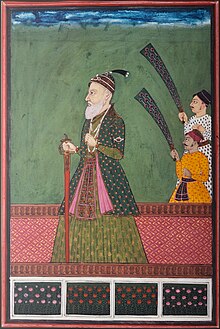
The Asaf Jahi dynasty originated in the region around Samarkand, but the family came to India from Baghdad in the late 17th century. Nawab Khwaja Abid Siddiqi ( Khulich Khan I ) s/o Shaikh Mir Ismail Siddiqi (Alam Shaikh Siddiqi) Alam ul-Ulema, son of Ayub Younus Salim Siddiqi, son of Abdul Rehman Shaikh Azizan Siddiqi, fourteenth in direct decent from Sheikh Shahab al-Din Suhrawardi, of Suhraward in Kurdistan, a celebrated Sufi mystic, or dervish, maternal (first), a lady of the family of Mir Hamadan (a descendant of the Prophet Mohammed) (SW), a distinguished Sayyid of Samarkand. They were direct descendants of the first Khalifa of Islam, Hazrat Abu Baker Al-Siddiq (R.A).
Origin of the title
Nizām-ul-mulk was a title first used in Urdu around 1600 to mean Governor of the realm or Deputy for the Whole Empire. The word is derived from the Arabic word, Nizām (نظام), meaning order, arrangement. The Nizam was referred to as Ala Hadrat / Ala Hazrat or Nizam Sarkar, meaning His Exalted Highness (The last Nizam was awarded this title. It is a hereditary title).
Rise of the Nizams
The first Nizam ruled on behalf of the Mughal emperors. After the death of Aurangzeb, the Nizams split from the Mughals to form an independent kingdom. When the British achieved paramountcy over India, the Nizams were allowed to continue to rule their princely states as client kings. The Nizams retained internal power over Hyderabad State until 17 September 1948 when Hyderabad was forcefully integrated into the new Indian Union.
The Asaf Jah dynasty had only seven rulers; however there was a period of 13 years after the rule of the first Nizam when three of his sons (Nasir Jung, Muzafar Jung and Salabath Jung) ruled. They were not officially recognized as the rulers.
A legend about the first Nizam states that, on one of his hunting trips he was offered some kulchas (an Indian bread) by a holy man and was asked to eat as many as he could. The Nizam could eat seven kulchas and the holy man then prophesied that seven generations of his family would rule the state.
By tradition no Nizam has ever left India no matter how good a reason might exist for doing so, as it was said, "the Sovereign is too precious to his people ever to leave India.".
Because Hyderabad did not participate in the first war of Indian Independence of 1857 against the British, its Royal Family had been accorded by British Royalty special honours and the Nizam was given the official status of Faithful Ally.
Infrastructure
During the period of Nizam rule, Hyderabad State became the richest,[1] and the senior-most salute state among the Indian princely states.[2] It was spread over 223,000 km2 (86,000 sq mi) in the Deccan, ruled by the Asaf Jahi dynasty. The Nizam's were conferred with the title of His Exalted Highness,[2] and "Faithful Ally of the British Government" by the United Kingdom,[3] becoming the only Indian prince to be given both these statuses.[4] The rule of the Nizams brought cultural and economic growth for Hyderabad city. One example of the wealth of Nizam rule is the Jewels of the Nizams, which is an international tourist attraction occasionally displayed in Salar Jung Museum. In 1948 Hyderabadstate had an estimated population of 17 million (1.7 crore), and it generated an estimated annual revenue of £90,029,000.[3] The state had its own currency known as the Hyderabadi rupee, until 1951.[5] The pace at which the last Nizam Mir Osman Ali Khan amassed wealth made him one of the world's richest men in 1937.[4] According to the Forbes All-Time Wealthiest List of 2008, Nizam Mir Osman Ali Khan is the fifth richest man ever, with an estimated worth of US$210.8 billion (adjusted with the present value of the US dollar).[5] The Nizams set up numerous institutions in the name of the dynasty including hospitals and schools, colleges, universities that imparted education in Urdu.[5] Inspired by the Indian Civil Service, the Nizams established the Hyderabad Civil Service and built large reservoirs. Survey work on the Nagarjuna Sagar Dam was initiated during this time, though the actual work was completed by the Government of India in 1969.[6][7]
List of Nizams of Hyderabad (1720-Present)
Nizams of Hyderabad (1720-1948)
| Image | Titular Name | Personal Name | Date of birth | Nizam From | Nizam Until | Date of death |
|---|---|---|---|---|---|---|
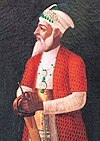 |
Nizam-ul-Mulk, Asaf Jah I نظامالملک آصف جاہ |
Mir Qamar-ud-din Khan | 20 August 1671 | 31 July 1720 | 1 June 1748 | |
 |
Nasir Jung نصیرجنگ |
Mir Ahmed Ali Khan | 26 February 1712 | 1 June 1748 | 16 December 1750 | |
 |
Muzaffar Jung مظفرجنگ |
Mir Hidayat Muhi-ud-din Sa'adullah Khan | ? | 16 December 1750 | 13 February 1751 | |
 |
Salabat Jung صلابت جنگ |
Mir Sa'id Muhammad Khan | 24 November 1718 | 13 February 1751 | 8 July 1762 (deposed) |
16 September 1763 |
 |
Nizam-ul-Mulk, Asaf Jah II نظامالملک آصف جاہ دوم |
Mir Nizam Ali Khan | 7 March 1734 | 8 July 1762 | 6 August 1803 | |
| Sikander Jah, Asaf Jah III سکندر جاہ ،آصف جاہ تریہم |
Mir Akbar Ali Khan | 11 November 1768 | 6 August 1803 | 21 May 1829 | ||
 |
Nasir-ud-Daula, Asaf Jah IV ناصر الدولہ ،آصف جاہ چارہم |
Mir Farqunda Ali Khan | 25 April 1794 | 21 May 1829 | 16 May 1857 | |
 |
Afzal-ud-Daula, Asaf Jah V افضال الدولہ ،آصف جاہ پنجم |
Mir Tahniyath Ali Khan | 11 October 1827 | 16 May 1857 | 26 February 1869 | |
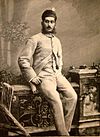 |
Asaf Jah VI آصف جاہ شیشم |
Mir Mahbub Ali Khan | 17 August 1866 | 26 February 1869 | 29 August 1911 | |
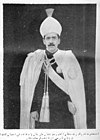 |
Asaf Jah VII آصف جاہ ہفتم |
Mir Osman Ali Khan | 6 April 1886 | 29 August 1911 | 17 September 1948 (deposed) |
24 February 1967 |
Titular Nizam of Hyderabad (1948-Present)
| Image | Titular Name | Personal Name | Date of birth | Pretender From | Pretender Until | Date of death |
|---|---|---|---|---|---|---|
 |
Asaf Jah VII آصف جاہ ہفتم |
Mir Osman Ali Khan | 6 April 1886 | 17 September 1948 | 24 February 1967 | |
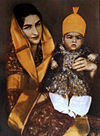 |
Mukarram Jah, Asaf Jah VIII مکرم جاہ ،آصف جاہ ہشتم |
Mir Barkat Ali Khan | 6 October 1933 | 24 February 1967 | Alive | |
Line of succession
The Asaf Jah dynasty followed the policy of male primogeniture during their long rule, regardless of the mother's marital status or rank. Currently, the line of succession to the Hyderabad throne is as follows:
The line of HEH Asaf Jah VIII
- HH Azmet Jah, the Prince of Berar (1960-). Eldest son of HEH Asaf Jah VIII.
- Azam Jah (1979-). Second son of HEH Asaf Jah VII
Descendants of HEH Asaf Jah VII

- Muffakham Jah (1939-). Younger brother of HEH Asaf Jah VIII.
- Rafat Jah (1966-). Elder son of Muffakham Jah.
- Farhad Jah. Younger son of Muffakham Jah.
- Shahamat Jah (1957-). Son of His Highness Moazzam Jah, the second son of HEH Asaf Jah VII.
- Mir Ahmad Ali Khan (1912-); fifth son of HEH Osman Ali Khan VII
- Ahmad Jah. Son of Kazim Jah (1912-1952), the sixth son of HEH Asaf Jah VII
- Sahibzada Mir Arshad Ali Khan; son of Ahmad Jah
- Baqir Jah; younger son of Kazim Jah (1912-1952)
- Sahibzada Mir Muhammad Jafar Ali Khan (1964-); elder son of Baqir Jah.
- Sahibzada Mir Kauser Ali Khan (1966-); younger son of Baqir Jah.
- Sahibzada Mir Banda Ali Khan (1951-); son of Abid Jah (1913-1983), the seventh son of HEH Asaf Jah VII.
- Sahibzada Mir Mushraf Ali Khan (1969-); son of Sahibzada Mir Banda Ali Khan.
- Sahibzada Mir Ata'ullah Khan (1957-); eldest son of Hashmat Jah (1913-1988), the eighth son of HEH Asaf Jah VII.
- Sahibzada Mir Rahmat ‘Ali Khan; second son of Hashmat Jah.
- Sahibzada Mir Hassan ‘Ali Khan (1959-); third son of Hashmat Jah.
- Sahibzada Mir Husain ‘Ali Khan (1961-); fourth son of Hashmat Jah.
- Sahibzada Mir Shamsher ‘Ali Khan (1941-); eldest son of Hashim Jah (1913-1991), the ninth son of HEH Asaf Jah VII.
- Sahibzada Mir Miraj ‘Ali Khan; second son of Hashim Jah.
- Sahibzada Mir Shahamat ‘Ali Khan (1942-); third son of Hashim Jah.
- Sahibzada Mir Baktiyar ‘Ali Khan (1964-); elder son of Sahibzada Mir Shahamat ‘Ali Khan.
- Sahibzada Mir Sulaiman ‘Ali Khan (1980-); younger son of Sahibzada Mir Shahamat ‘Ali Khan.
- Sahibzada Mir Kawkab ‘Ali Khan; fourth son of Hashim Jah.
- Sahibzada Mir Zamin ‘Ali Khan (1948-); fifth son of Hashim Jah.
- Sahibzada Mir Muhammad Jaffar ‘Ali Khan (1978-); son of Sahibzada Mir Zamin ‘Ali Khan.
- Sahibzada Mir Haider ‘Ali Khan (2000-); son of Sahibzada Mir Muhammad Jaffar ‘Ali Khan.
- Sahibzada Mir Murtuza ‘Ali Khan (2007-); son of Sahibzada Mir Muhammad Jaffar ‘Ali Khan.
- Sahibzada Mir Askar ‘Ali Khan; sixth son of Hashim Jah.
- Sahibzada Mir Muhammad Nusrath ‘Ali Khan; seventh son of Hashim Jah.
- Sahibzada Mir Muhammad Hussain ‘Ali Khan (1970-); son of Sahibzada Mir Muhammad Nusrath ‘Ali Khan.
- Sahibzada Mir Karam ‘Ali Khan (1956-); eighth son of Hashim Jah.
- Sahibzada Mir Osman ‘Ali Khan (1985-); son of Sahibzada Mir Karam ‘Ali Khan.
- Sahibzada Mir Najaf ‘Ali Khan (1964-); ninth son of Hashim Jah.
- Sahibzada Muhammad Anas Ali Khan (2001-); son of Sahibzada Mir Najaf ‘Ali Khan.
- Sahibzada Mir Naqi ‘Ali Khan. Elder son of Taqi Jah (1913-1985), tenth son of HEH Asaf Jah VII
- Sahibzada Mir Ja’afar ‘Ali Khan. Younger son of Taqi Jah.
- Sahibzada Mir Firasath ‘Ali Khan; eldest son of Sa’adat Jah (1917-1988), nineteenth son of HEH Asaf Jah VII
- Sahibzada Mir Saqafath ‘Ali Khan. (1968-); fourth son of Sa'adat Jah.
- Imdad Jah (1944-); twenty-third son of HEH Asaf Jah VII
- Dilshad Jah (1963-); elder son of Imdad Jah
- Sahibzada Mir Irshad ‘Ali Khan (1977-); younger son of Imdad Jah.
- Son of Nawazat Jah (1944-2010); twenty-fifth son of HEH Asaf Jah VII
- Son of Nawazat Jah
- Fazal Jah (1946-); twenty-sixth son of HEH Asaf Jah VII
- Sahibzada Mir Salabat ‘Ali Khan (1969-); son of Bhojat Jah (1947-1982), twenty-seventh son of HEH Asaf Jah VII
- Sahibzada Mir Bhojat ‘Ali Khan (1998-), son of Sahibzada Mir Salabat ‘Ali Khan.
- Manzoor Ahmad Nizami (1926-2008), son of Nizam Uddin Asaf Jah VII.
- HEH Farooq Nizami (1965-), son of Manzoor Ahmad Nizami Asaf Jah VII.
- Sahibzada Feroz Nizami (1994-), son of Farooq Nizami HEH Asaf Jah VII.
- Sahibzada Muhammad Bin Farooq (2003), Nizam, son of Farooq Nizami HEH Asaf Jah VII.
'Descendants of Asaf Jah III'
- Sahibzada Mir Jamil ud-din ‘Ali Khan (1940-). Descended from Asaf Jah III through his second son Samsam ul-Mulk, Sunisamad ud-Daula, Nawab Mir Bashir ud-din 'Ali Khan Bahdur, Samsan Jang (1797-1876), through his seventh son Nawab Mir Habib 'Ali Khan Bahadur, Muazziz Jang (1821-?), through his son Sahibzada Mir Yusuf 'Ali Khan (1856-19?), through his son Sahibzada Mir Habib 'Ali Khan Bahadur (1900-1937) and through his son Sahibzada Mir Bashir ud-din Ali Khan Bahadur (1921-1980).
- Sahibzada Jaweed Siddiqi (1966-). Son of Sahibzada Mir Jamil ud-din ‘Ali Khan.
- Sahibzada Bashir Siddiqi (1999-). Son of Sahibzada Jaweed Siddiqi.
- Sahibzada Abrar Siddiqi (2001-). Son of Sahibzada Jaweed Siddiqi.
- Shahizada Mir farooq Ali Khan . Son of Mir Moinuddin Ali Khan.son of mir bahauddin ali khan uzzam-ud-daula saham-jung son of samsam-ud-daula
- Sahibzada Mir Moiz ud-din ‘Ali Khan (1954-). Son of Sahibzada Mir farooq Ali Khan(1924-1986)
- Shahizada Mir Mohiuddin Ali Khan & Shahizada Mir Farooq Ali Khan Son of Mir Moiz uddin Ali Khan.
- shahibzadi Mir Sadia Moiz D/o.Shahibzada Mir Moiz uddin Ali Khan(Wife of Shaikh ilyas Ahmed).
- Sahibzada Mir Azmat 'Ali Khan (1944-). Son of Nawab Mir Husain 'Ali Khan Bahadur (1923-1987), the second son of Sahibzada Mir Habib 'Ali Khan Bahadur.
- Sahibzada Mir Himayath 'Ali Khan (1984-). Eldest son of Sahibzada Mir Azmat 'Ali Khan.
- Sahibzada Mir Azam 'Ali Khan (1989-). Second son of Sahibzada Mir Azmat 'Ali Khan.
- Sahibzada Mir Mazhar 'Ali Khan (2001-). Third son of Sahibzada Mir Azmat 'Ali Khan.
- Sahibzada Mir Osman 'Ali Khan (1952-). Second son of Nawab Mir Husain Ali Khan Bahadur.
- Sahibzada Mir Khader 'Ali Khan (1955-). Third son of Nawab Mir Husain Ali Khan Bahadur.
- Sahibzada Mir Tawfeeq 'Ali Khan (1983-). Elder son of Sahibzada Mir Khader 'Ali Khan.
- Sahibzada Mir Mujahid 'Ali Khan (1995-). Second son of Sahibzada Mir Khader 'Ali Khan.[8]
Family tree
I. Qamar-ud-din Khan, Asaf Jah I, 1st Nizam of Hyderabad (20 August 1671 - 1 June 1748). A senior governor and counsellor in the Imperial government. Defeated the Imperial forces on 19 June 1720 at Hasanpur and formed an independent state of his own. Confirmed in his possessions by Imperial firman and crowned on 31 July. Named Vice-Regent of the Mughal Empire by the Emperor Muhammad Shah on 8 February 1722, secured the province of Berar on 11 October 1724 and formally made Hyderabad City his new capital on 7 December 1724. Died at Burhampur on 1 June 1748, aged 76. He had six sons and seven daughters, including:
- II. Nasir Jang Mir Ahmad, 2nd Nizam of Hyderabad (26 February 1712 - 16 December 1750). Ruled from 1 June 1748 - 16 December 1750, when he was killed aged 38 by the Nawab of Kadapa.
- Sahibzadi Khair un-nisa Begum. Married Nawab Talib Muhi ud-din Mutasawwil Khan Bahadur, Muzaffar Jang. She had issue, a son:
- III. Muhyi ad-Din Muzaffar Jang Hidayat, 3rd Nizam of Hyderabad (d. 13 February 1751). Succeeded upon his uncle's death; ruled from 16 December 1750 - 13 February 1751, when he was killed by the Nawab of Kurnool.
- IV. Asaf ad-Dawlah Mir Ali Salabat Jang, 4th Nizam of Hyderabad (November 1718 - 16 September 1763). Succeeded his brother, ruling from 13 February 1751 - 8 July 1762. Deposed by his brother on 8 July 1762 and killed in prison the following year, aged 44.
- V. Ali Khan Asaf Jah II, 5th Nizam of Hyderabad (7 March 1734 - 6 August 1803). Ruled 8 July 1762 - 6 August 1803, when he died aged 69. He had 11 sons and 12 daughters, including:
- VI. Mir Akbar Ali Khan Sikander Jah, Asaf Jah III, 6th Nizam of Hyderabad (11 November 1768 - 21 May 1829). The first of the dynasty to be officially granted the title of Nizam. Ruled 6 August 1803 - 21 May 1829, when he died aged 60. He had 10 sons and nine daughters, including:
- VII. Nasir-ud-dawlah, Asaf Jah IV, 7th Nizam of Hyderabad (25 April 1794 - 16 May 1857). Ruled 21 May 1829 - 16 May 1857, when he died aged 63. He had five sons, including:
- VIII. Afzal ad-Dawlah, Asaf Jah V, 8th Nizam of Hyderabad, GCSI (11 October 1827 - 26 February 1869). The first of the Nizams to fall under British rule. Ruled 16 May 1857 - 26 February 1869, when he died aged 41. He had four sons and six daughters, including:
- IX. Mahbub Ali Khan, Asaf Jah VI, 9th Nizam of Hyderabad, GCB, GCSI, KIH (17 August 1866 - 31 August 1911). Succeeded his father on 26 February 1869, ruled under a regency until 5 February 1884, when he was invested with full ruling powers by the Viceroy of India. Died 31 August 1911, aged 45. He had seven sons and six daughters, including:
- X. Osman Ali Khan, Asaf Jah VII, 10th Nizam of Hyderabad, GCSI, GBE, Royal Victorian Chain, MP (6 April 1886 - 24 January 1967). Granted the style of His Exalted Highness (1 January 1918), the title of Faithful Ally of the British Government (24 January 1918) and Nizam of Hyderabad and of Berar (13 November 1936). The last of the ruling Nizams; ruled absolutely from 31 August 1911 - 19 September 1948, when the state was formally annexed to the Union of India. Maintained semi-ruling and semi-autonomous status from then until 23 November 1949, when he accepted the paramountcy of the new Indian government and Constitution and acceded to the Union. Formally lost his sovereignty, ending 230 years of Asaf Jahi rule, upon the formal promulgation of the Constitution on 26 January 1950. Served as Rajpramukh of the new Hyderabad State from 26 January 1950 until 31 October 1956, when the post was abolished. Served as a titular monarch from 26 January 1950 until his death on 24 January 1967, aged 80. He had children, 28 sons and 44 daughters, including:
- HH Azam Jah, Prince of Berar, GCIE, GBE, MSM (21 February 1907 - 9 October 1970). Granted the title of His Highness the Prince of Berar (13 November 1936). Passed over in the line of succession in 1967 in favour of his elder son. He had two sons, including the elder:
- XI. Barkat Ali Khan Mukarram Jah, Asaf Jah VIII, 11th Nizam of Hyderabad (6 October 1933-). Succeeded his grandfather as titular monarch on 24 January 1967; titles abolished by the Indian Government on 28 December 1971. He has children that included two sons.
- HH Azam Jah, Prince of Berar, GCIE, GBE, MSM (21 February 1907 - 9 October 1970). Granted the title of His Highness the Prince of Berar (13 November 1936). Passed over in the line of succession in 1967 in favour of his elder son. He had two sons, including the elder:
- X. Osman Ali Khan, Asaf Jah VII, 10th Nizam of Hyderabad, GCSI, GBE, Royal Victorian Chain, MP (6 April 1886 - 24 January 1967). Granted the style of His Exalted Highness (1 January 1918), the title of Faithful Ally of the British Government (24 January 1918) and Nizam of Hyderabad and of Berar (13 November 1936). The last of the ruling Nizams; ruled absolutely from 31 August 1911 - 19 September 1948, when the state was formally annexed to the Union of India. Maintained semi-ruling and semi-autonomous status from then until 23 November 1949, when he accepted the paramountcy of the new Indian government and Constitution and acceded to the Union. Formally lost his sovereignty, ending 230 years of Asaf Jahi rule, upon the formal promulgation of the Constitution on 26 January 1950. Served as Rajpramukh of the new Hyderabad State from 26 January 1950 until 31 October 1956, when the post was abolished. Served as a titular monarch from 26 January 1950 until his death on 24 January 1967, aged 80. He had children, 28 sons and 44 daughters, including:
- IX. Mahbub Ali Khan, Asaf Jah VI, 9th Nizam of Hyderabad, GCB, GCSI, KIH (17 August 1866 - 31 August 1911). Succeeded his father on 26 February 1869, ruled under a regency until 5 February 1884, when he was invested with full ruling powers by the Viceroy of India. Died 31 August 1911, aged 45. He had seven sons and six daughters, including:
- VIII. Afzal ad-Dawlah, Asaf Jah V, 8th Nizam of Hyderabad, GCSI (11 October 1827 - 26 February 1869). The first of the Nizams to fall under British rule. Ruled 16 May 1857 - 26 February 1869, when he died aged 41. He had four sons and six daughters, including:
- VII. Nasir-ud-dawlah, Asaf Jah IV, 7th Nizam of Hyderabad (25 April 1794 - 16 May 1857). Ruled 21 May 1829 - 16 May 1857, when he died aged 63. He had five sons, including:
- VI. Mir Akbar Ali Khan Sikander Jah, Asaf Jah III, 6th Nizam of Hyderabad (11 November 1768 - 21 May 1829). The first of the dynasty to be officially granted the title of Nizam. Ruled 6 August 1803 - 21 May 1829, when he died aged 60. He had 10 sons and nine daughters, including:
italics - Considered pretenders by most historians; did not hold much power during their reigns.
Palaces of the Nizams
The Asaf Jahis were prolific builders. Several palaces of the Nizams were:
- Chowmahalla Palace
- Purani Haveli
- King Kothi Palace
- Hyderabad House, New Delhi.
- Mahboob Mansion
- Falaknuma Palace
- Bella Vista
- Hill Fort Palace
- Chiran Palace
- Bashir Bagh Palace
Other landmarks like the Andhra Pradesh High Court, Jubilee Hall, Asafia library, The Assembly building, the Osmania Arts College and the Osmania Medical College are among their notable constructions.
The Nizams liked the European style of architecture and created a fusion of European traditions with Hindu and Islamic forms and motifs.
End of the Dynasty and Removal of the Last Nizam

After the British left India in 1947, the princely state of Hyderabad did not accede to either of the new dominions of India or Pakistan and started taking support and arms from Pakistan. After attempts by India to persudade the Nizam to accede to India failed, the Indian government launched Hyderabad police action on 13 September 1948, swiftly overrunning the Nizam's forces within four and a half days. The Nizam capitulated and his forces surrendered on 17 September 1948 and he broadcast this over radio the same afternoon. His rule ended on 17 September 1948. It was the end of the dynasty.
Mir Osman Ali Khan, the last Nizam, died on Friday 24 February 1967. All Nizams are buried in the royal graves at the Makkah Masjid near Charminar in Hyderabad except for the last Nizam, Mir Osman Ali Khan, who willed that he be buried beside his mother, in the grave yard of Judi Mosque facing King Kothi Palace.
Places and things named after the Nizam
- Jamia Nizamia university
- Nizam College
- Nizam's Museum
- Nizam's Guaranteed State Railway
- Nizam's Institute of Medical Sciences
- Jewels of the Nizams
- Nizam Diamond
- Nizam Sagar
- HMAS Nizam, a Royal Australian Naval vessel named for the Nizam prince who helped finance her construction
- Nizamia observatory
- Nizam Club
See also
- Osmanistan
- Hyderabad State
- Hyderabadi Muslims
- Carnatic Wars
- History of Hyderabad, India
- Paigah
- Salar Jung family
- List of Sunni Muslim dynasties
References
- ^ "Hyderabad:silver jubilee durbar". Time (magazine). 22 February 1937. Retrieved 15 September 2011.
- ^ a b M.A., Choudhary; Gautam, Chaudhary (2009). Global encyclopedia of political geography. Global Vision Publishing House. p. 186. ISBN 978-81-8220-233-7.
{{cite book}}:|access-date=requires|url=(help) - ^ a b "Hyderabad:the holdout". Time (magazine). 30 August 1948. Retrieved 10 October 2011.
- ^ a b "Richest Indian in history!". Daily Star (United Kingdom). 23 July 2010. Retrieved 15 September 2011.
- "Making money the royal way". The Economic Times. 23 April 2008. Retrieved 15 September 2011.
- ^ a b c "Jewel in the crown: a palace fit for a Nizam". The Guardian. 20 February 2011. Retrieved 15 September 2011.
- ^ Mahmood Bin, Muhammad (1999). A policeman ponders: memories and melodies of a varied life. A.P.H.Publishing Corporation. p. 19. ISBN 978-81-7648-026-0.
{{cite book}}:|access-date=requires|url=(help) - ^ Rann Singh, Mann (1996). Tribes of India:ongoing challenges. MD Publication Pvt Ltd. p. 310. ISBN 81-7533-007-4.
{{cite book}}:|access-date=requires|url=(help)- A.Ranga, Reddy (2003). The state of Rayalaseema. Naurang Rai, Mittal Publication. p. 5. ISBN 978-81-7099-814-3.
{{cite book}}:|access-date=requires|url=(help) - P.V, Kate (1987). Marathwada Under the Nizams, 1724-1948. Mittal Publications. pp. 23–47. ISBN 81-7099-017-3.
{{cite book}}:|access-date=requires|url=(help)
- A.Ranga, Reddy (2003). The state of Rayalaseema. Naurang Rai, Mittal Publication. p. 5. ISBN 978-81-7099-814-3.
- ^ [1]
- ^ [2]
- Zubrzycki, John (2006). The Last Nizam: An Indian Prince in the Australian Outback. Australia: Pan Macmillan. ISBN 978-0-330-42321-2.
- Regani, Sarojini (1988) [First published 1963]. Nizam-British Relations, 1724-1857. New Delhi: Concept Publishing Company. ISBN 978-81-7022-195-1.
- Hastings, Fraser (1865). Our Faithful Ally, the Nizam. London: Smith, Elder & Co.
- Briggs, Henry George (1861). The Nizam: His History and Relations With the British Government, Volume 1. London: B. Quaritch.
- Lynton, Harriet Ronken; Rajan, Mohini (1974). The Days of the Beloved. University of California Press. ISBN 0-520-02442-7.
- University of Queensland feature
Further reading
- Mughal Administration of Deccan Under Nizamul Mulk Asaf Jah, 1720-48 A.D.By M. A. Nayeem, Indian Council of Historical Research, University of Poona, Dept. of History [3]
"The Days of the Beloved" Harriet Ronken Lynton and Mohini Rajan, Berkeley University Press
